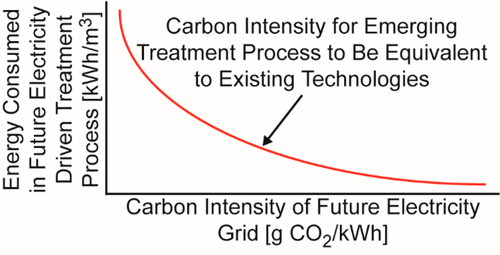当前位置:
X-MOL 学术
›
ACS ES&T Eng.
›
论文详情
Our official English website, www.x-mol.net, welcomes your
feedback! (Note: you will need to create a separate account there.)
Carbon Benefits of Drinking Water Treatment Electrification
ACS ES&T Engineering ( IF 7.4 ) Pub Date : 2021-08-04 , DOI: 10.1021/acsestengg.1c00165 Daniel B. Gingerich 1 , Jiachen Liu 2 , Meagan S. Mauter 1
ACS ES&T Engineering ( IF 7.4 ) Pub Date : 2021-08-04 , DOI: 10.1021/acsestengg.1c00165 Daniel B. Gingerich 1 , Jiachen Liu 2 , Meagan S. Mauter 1
Affiliation

|
Water treatment electrification, or the substitution of chemically-driven processes for electricity-driven processes to produce equivalent water quality, will be critical to decarbonizing our water supply. This work quantitatively assesses the carbon reduction potential of electrified unit processes for the removal of suspended solids, divalent ions, and organic compounds relative to chemically-intensive conventional coagulation, softening, and sorption processes. Several electrified technologies─including electrocoagulation, nanofiltration, and packed tower aeration─already reduce carbon emissions relative to the corresponding chemically-driven treatment processes under certain water quality conditions. Other electrified substitutes increase net carbon emissions for the carbon intensity of the 2020 grid but will reduce carbon emissions by 2050 as the electricity grid decarbonizes over the expected lifespan of the unit process. For electrified processes that are more carbon intense than conventional processes, we identify electricity consumption targets that would yield breakeven carbon emissions. Finally, we evaluate the potential for intensified treatment technologies (e.g., use of nanofiltration for simultaneous organics concentration reduction and divalent ion removal) to reduce carbon emissions when a single purpose application would not.
中文翻译:

饮用水处理电气化的碳效益
水处理电气化,或用化学驱动工艺替代电力驱动工艺以产生同等水质,对于我们的供水脱碳至关重要。这项工作定量评估了电气化单元工艺相对于化学密集型常规混凝、软化和吸附工艺去除悬浮固体、二价离子和有机化合物的碳还原潜力。在某些水质条件下,与相应的化学驱动处理工艺相比,一些电气化技术——包括电凝聚、纳滤和填料塔曝气——已经减少了碳排放。其他电气化替代品增加了 2020 年电网碳强度的净碳排放量,但到 2050 年将减少碳排放量,因为电网在单元过程的预期寿命期内脱碳。对于比传统工艺碳强度更高的电气化工艺,我们确定了能够产生盈亏平衡碳排放的电力消耗目标。最后,我们评估了强化处理技术(例如,使用纳米过滤同时降低有机物浓度和去除二价离子)在单一用途应用无法减少碳排放的潜力。我们确定了能够产生盈亏平衡碳排放的电力消耗目标。最后,我们评估了强化处理技术(例如,使用纳米过滤同时降低有机物浓度和去除二价离子)在单一用途应用无法减少碳排放的潜力。我们确定了能够产生盈亏平衡碳排放的电力消耗目标。最后,我们评估了强化处理技术(例如,使用纳米过滤同时降低有机物浓度和去除二价离子)在单一用途应用无法减少碳排放的潜力。
更新日期:2021-08-04
中文翻译:

饮用水处理电气化的碳效益
水处理电气化,或用化学驱动工艺替代电力驱动工艺以产生同等水质,对于我们的供水脱碳至关重要。这项工作定量评估了电气化单元工艺相对于化学密集型常规混凝、软化和吸附工艺去除悬浮固体、二价离子和有机化合物的碳还原潜力。在某些水质条件下,与相应的化学驱动处理工艺相比,一些电气化技术——包括电凝聚、纳滤和填料塔曝气——已经减少了碳排放。其他电气化替代品增加了 2020 年电网碳强度的净碳排放量,但到 2050 年将减少碳排放量,因为电网在单元过程的预期寿命期内脱碳。对于比传统工艺碳强度更高的电气化工艺,我们确定了能够产生盈亏平衡碳排放的电力消耗目标。最后,我们评估了强化处理技术(例如,使用纳米过滤同时降低有机物浓度和去除二价离子)在单一用途应用无法减少碳排放的潜力。我们确定了能够产生盈亏平衡碳排放的电力消耗目标。最后,我们评估了强化处理技术(例如,使用纳米过滤同时降低有机物浓度和去除二价离子)在单一用途应用无法减少碳排放的潜力。我们确定了能够产生盈亏平衡碳排放的电力消耗目标。最后,我们评估了强化处理技术(例如,使用纳米过滤同时降低有机物浓度和去除二价离子)在单一用途应用无法减少碳排放的潜力。











































 京公网安备 11010802027423号
京公网安备 11010802027423号